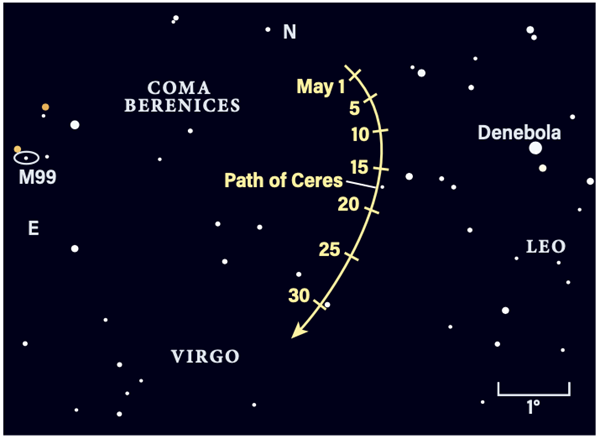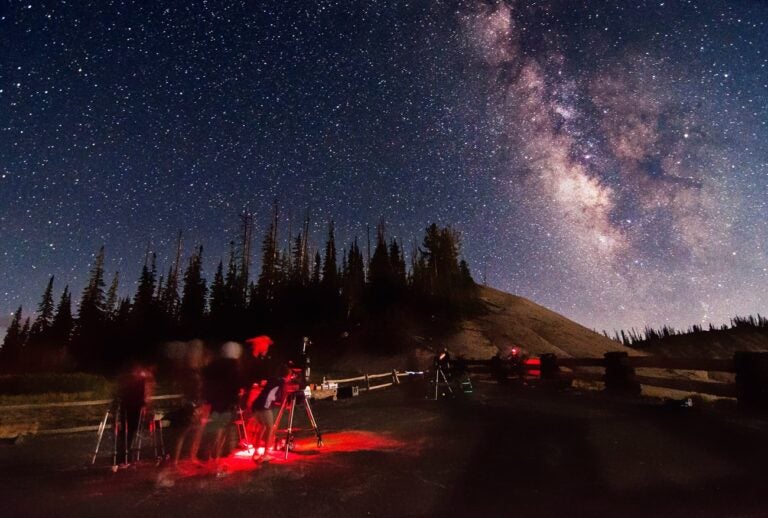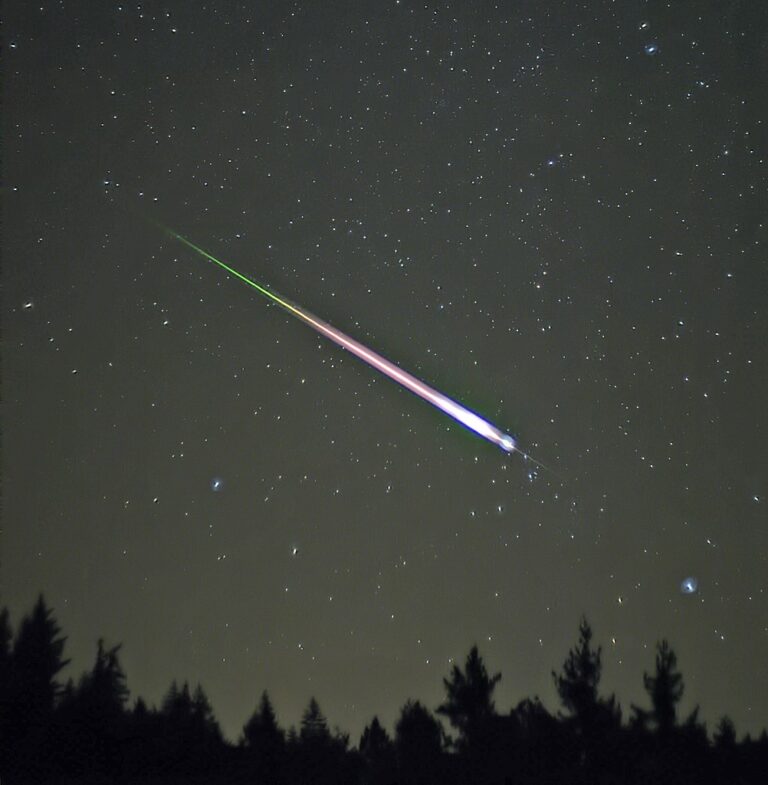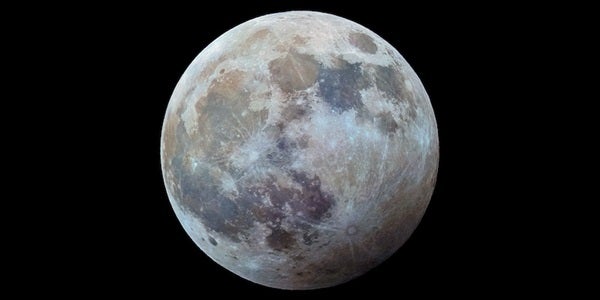
Venus puts on its best show of the year in the evening sky, visible until very late. Mars also continues as an evening object, while other planets congregate in the morning. Saturn is beginning to improve its visibility in the predawn sky and Jupiter, reappearing after solar conjunction, takes part in a spectacular twilight occultation by the Moon.
We start the monthly tour with Venus shining brilliantly in the western sky. It glows at magnitude –4.1 at the start of the month and brightens by three-tenths of a magnitude by May 31. You’ll find it nicely placed between the horns of Taurus the Bull on the 1st.
Venus exits Taurus a week later and moves to a point north of Eta (η) and Mu (μ) Geminorum on May 9, when it achieves its maximum declination north (26°) and its farthest point above the ecliptic. A telescope will show a gibbous disk 63 percent lit and 18″ across.
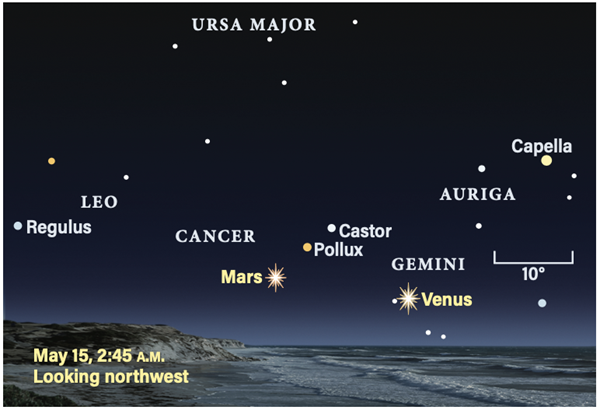
This northerly extent places Venus in interesting parts of the sky for northern tiers of the U.S. and particularly in Canada and Alaska. Normally visible in the western sky after sunset, Venus is almost circumpolar for Anchorage, Alaska, and is visible at midnight in the northwestern sky. Shortly before 3 A.M. local time, Venus lies low on the northwestern horizon, an unusual placement for an inferior planet. During the long twilight, Venus remains situated north. From Fairbanks, Alaska, Venus lies due north at sunrise, sitting 1° above the horizon.
Venus continues across Gemini and ends the month south of Pollux, similar to the location of Mars early in the month. A telescope shows Venus close to half phase (dichotomy) on May 31, with a 52-percent-lit disk spanning 23″.
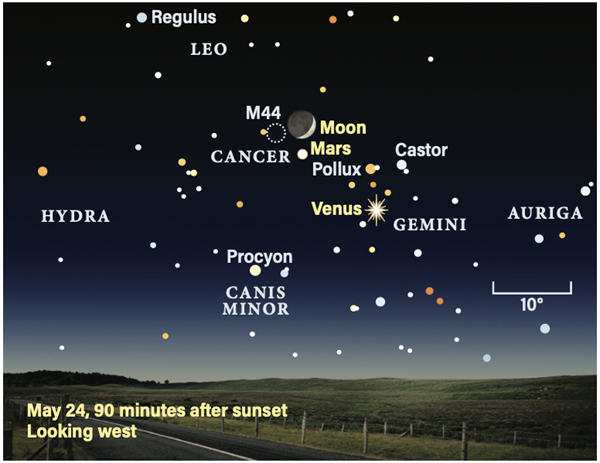
Mars is 5° due south of Pollux on May 9. The Red Planet is magnitude 1.4; Pollux shines brighter at magnitude 1.2. Mars crosses into Cancer by May 17 and drifts closer to the famous Beehive Cluster (M44). A crescent Moon arrives 3° north of M44 on May 24, with Mars standing 5° west of the cluster.
Mars ends the month only 1° shy of M44: a beautiful pairing setting up the first couple of days of June, when Mars crosses the cluster. Note that Venus stands only 11° away, a few degrees south of Pollux. Through a telescope, Mars presents a tiny disk spanning 5″, making it a challenge to see any surface detail except under perfect conditions. The Red Planet, now passing 2 astronomical units from Earth, sets soon after midnight. (One astronomical unit, or AU, is the average Earth-Sun distance.)
Saturn rises about 3:30 A.M. local time on May 1 and is up by 1:30 A.M. on May 31. Its altitude improves greatly in the hour before dawn throughout the month. It lies in mid-Aquarius and is by far the brightest object (magnitude 0.8 most of the month) in the vicinity. Fomalhaut in Piscis Austrinus is the closest 1st-magnitude star. It lies about 20° to Saturn’s south and rises about 90 minutes later.
The hour before dawn is a fine time to view the ringed planet, when Saturn stands at more than 20° elevation in the southeastern sky. The rings are tilted by 8° to our line of sight, presenting a beautiful view. Both northern and southern hemispheres of the disk are on show, spanning 17″. It’s a good time to look out for any storms brewing in the normally quiescent saturnian atmosphere.
Saturn’s brightest moon, Titan, shines at magnitude 8.7. It stands due north of the planet on May 4 and 20, and due south on May 12 and 28. Other moons are fainter and closer in, while Iapetus, farther out, reaches its faint eastern elongation on May 14. We will revisit these moons in the coming months as Saturn’s visibility improves.
Lying at the remote edge of our solar system, the distant planet Neptune can be spotted with binoculars. It shines at magnitude 7.8. The ice giant rises nearly an hour after Saturn and remains low in the east an hour before dawn on May 1, a difficult object to spot.
Neptune’s visibility improves by May 31, when it stands about 20° high in the eastern sky at the onset of twilight. The dim bluish object lies within 1° of 20 Piscium, a 5th-magnitude field star, forming a triangle together with 24 Piscium. The three lie some 5° southeast of 4th-magnitude Lambda (λ) Piscium. From night to night, Neptune wanders east, farther from 20 Piscium.
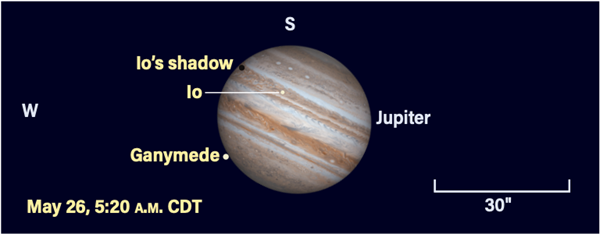
Jupiter sits about 10° above the eastern horizon one hour before sunrise at the end of May. The giant planet reappears in the morning sky among the stars of Aries the Ram, shining at an easy-to-spot magnitude of –2.1. May is a good time to get acquainted with Jupiter again after a couple of months of limited viewing. Check on its atmospheric activity to see if any new features have arisen after solar conjunction.
Don’t miss the lunar occultation of Jupiter the morning of May 17. The exact timing of the event varies based on your location. Watch the pair rise around 4:30 A.M. local time and, as twilight brightens in the Midwest (it’s already daylight on the East Coast), the limb of the Moon approaches Jupiter, hiding the giant planet around 7:11 A.M. EDT in Miami, 7:21 A.M. EDT in Atlanta, 7:45 A.M. EDT in Boston, 6:29 A.M. CDT in Kansas City, 6:36 A.M. CDT in Chicago, and 6:32 A.M. CDT in Denver. It takes almost a minute for the Moon to completely cover the planet.
The first mutual Galilean satellite event that you can easily observe occurs May 26, when Io and its shadow are crossing Jupiter’s disk as the planet rises. As twilight grows across the Midwest, Io’s shadow leaves the disk at 5:24 A.M. CDT. Ganymede soon disappears behind the same limb of Jupiter at 5:27 A.M. CDT.
Uranus is too close to the Sun for observation during much of the month. Catch it in the half hour before sunrise in late May.
Mercury reaches inferior conjunction May 1 and moves into the morning sky shortly after, but remains faint and beyond reach for the first three weeks of the month. On May 23, it reaches magnitude 1 and is located 7° due east of brighter Jupiter, which acts as a nice guide to finding the innermost planet. Mercury is 4° high 30 minutes before sunrise. Six days later, it reaches its greatest elongation west of the Sun (25°) at magnitude 0.5. Its location south of the ecliptic keeps Mercury hugging the eastern horizon while Jupiter pulls away, higher in the sky. At the end of May, the two planets are separated by a dozen degrees.
A deep penumbral eclipse of the Moon occurs on the evening of May 5 for observers in Africa, Asia, Australia, and New Zealand. For most of the eclipse not much is evident, but during greatest eclipse (17:24 UTC), when more than 90 percent of the Moon is inside the penumbra, the northern limb will appear noticeable dusky. The eclipse is not visible from the U.S.
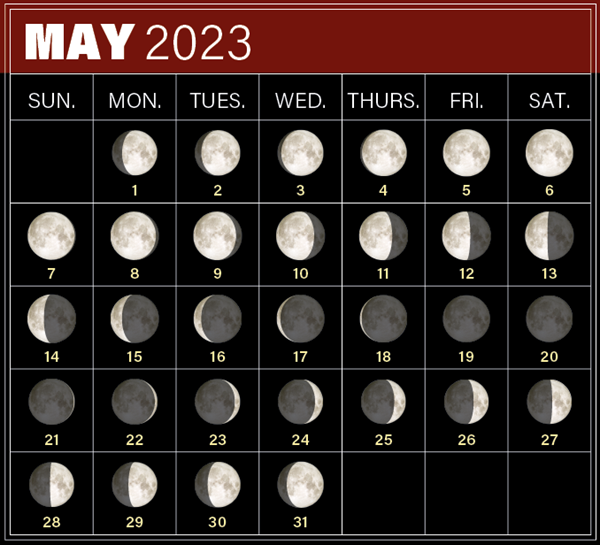
Rising Moon: Moon mounds
What a sight the Moon must have been 3 billion years ago: Lava surging from the lunar interior and spreading across huge basins! As the surface cooled and solidified, local upwellings over hot spots continued here and there. In contrast to the depth, violence, and superspeed of impact cratering, the Rümker hills rose relatively slowly and reached only modest heights.
A good look at this topographic mound means observing on the 2nd. Its unusual nature is eye-catching. The eastern flank just does not look like the rim of a walled crater. It’s as if the Moon had hives that day.
The gentle hills cast long shadows under the rising Sun, but a mere 24 hours later, they have all but disappeared. We can’t know for sure that the flat central part is a caldera, but it looks like the hole left from the collapse of the peak, which then flooded with magma. Rümker returns to visibility late on the 31st.
Locate the fascinating volcanic feature by starting at the brilliant Aristarchus, then slide north along the wrinkled terminator. The terrain around Aristarchus was also molded by long-lived flows of lava. There is so much to take in here! Farther south lie the volcanic domes near the crater Marius and the huge bowl of Schickard.
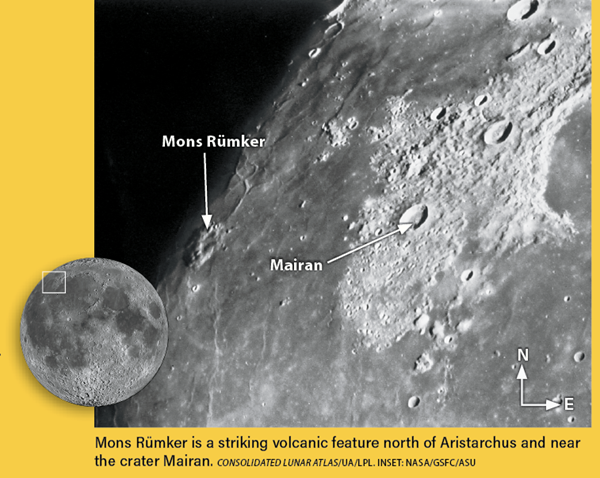
Meteor Watch: Halley’s leftovers
This month’s Eta Aquariid Shower is active between April 19 and May 28, peaking on May 6. The peak of the meteor shower is heavily affected by the Full Moon (May 5), which remains visible all night. The typical zenithal hourly rate of 50 per hour on May 6 is severely reduced to a trickle, with only the brighter members observable. The low altitude of the radiant doesn’t help, either. It rises just after 2 A.M. local time on the morning of maximum and reaches about 20° above the horizon as twilight breaks. Try observing during the first few of days of May to catch any early shower members after the Moon sets (4:30 A.M. on May 2).
The Eta Aquariids are one of two showers associated with Halley’s Comet, whose dusty debris left over from hundreds of orbits also results in the October Orionids.
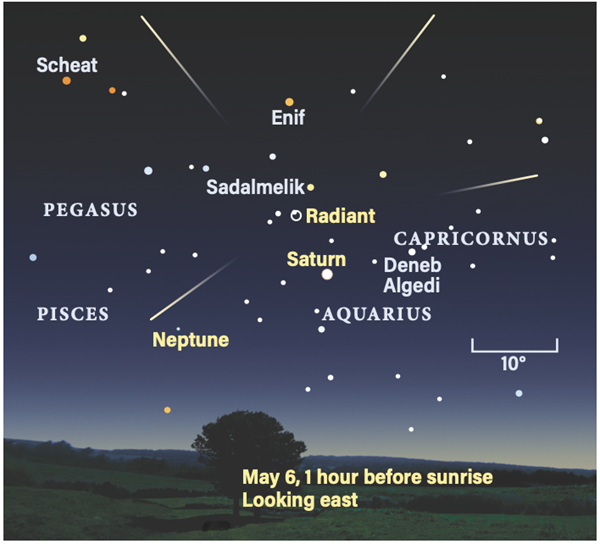
Comet Search: Practice, patience, and power
With a pause in bright comets, take advantage of milder spring nights to leave the rush behind and push your skills in detecting faint structure over a range of magnifications.
Under a dark sky in the second half of the month, begin at low power on the Lagoon Nebula (NGC 6523) after midnight. Shift 1.5° east-northeast to NGC 6559. Imagine the 10th-magnitude star at its center is the core of a comet, then push it to the side. Slowly swoop the scope around, keeping the star just outside the edge of the field. The uneven nebula should be rewarding because one side is long and narrow like a comet tail.
Next, jump to northeastern Sagittarius and NGC 6822. Half the apparent diameter of the Moon, the dwarf elliptical galaxy can be seen in a 4-inch scope. Not even a degree north lies a magnitude 9.4 version of Uranus: planetary nebula NGC 6818, also called the Little Gem. Crank up the power to extract shape and brightness differences from a starting estimate of round.
From there, some 5° north-northeast lands us at Comet 237P/LINEAR. If it is in outburst, an 8-inch scope will do it, but more likely you’ll need a 12-inch mirror to see the 13th-magnitude fuzz. Use 150x or more to darken the sky background and make the small cloud of dust appear big enough for your brain to recognize it. To the south, the pair of magnitude 12.5 and 12.9 galaxies serve as a comparison. LINEAR never crosses Mars’ orbit, but every 6.6 years loops out to Jupiter’s domain.
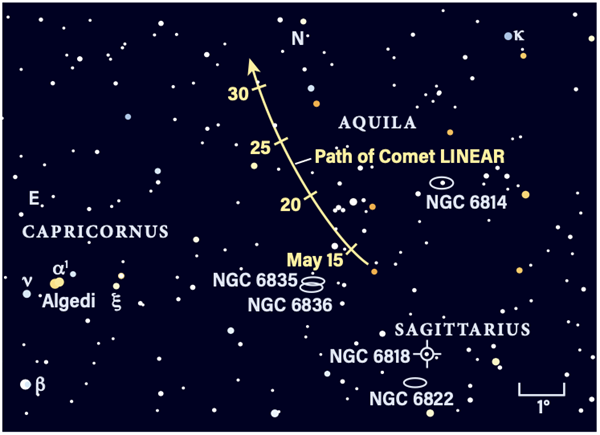
Locating Asteroids: Easy pickings
Perfect for a small scope in the suburbs, magnitude 7.7 1 Ceres rides with Leo high in the south as darkness sets in. It’s only half a binocular field east (left) of the bright star Denobola. (That name’s Arabic roots mean “tail of the lion.” Deneb of the Summer Triangle is the tail of Cygnus the Swan, but over time its full name was shortened to its current moniker.)
There are so few background stars here that our target will often be the brightest dot in the field of view. However, you won’t see it shift during an observing session. The main-belt asteroid is just coming out of the western end of its retrograde loop as Earth runs ahead on our inner orbit, making Ceres appear to move slowly. But plotting it against four other stars in a logbook every third night will show the shift.
Don’t bother when Moon is nearby — May 1 and the 27th onward — because the scattered light will make a sighting difficult. A spherical 600 miles across, Ceres was the first asteroid discovered and was later offered a spot in the dwarf planet club.
